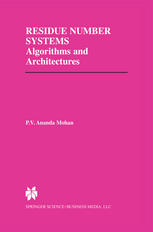

Most ebook files are in PDF format, so you can easily read them using various software such as Foxit Reader or directly on the Google Chrome browser.
Some ebook files are released by publishers in other formats such as .awz, .mobi, .epub, .fb2, etc. You may need to install specific software to read these formats on mobile/PC, such as Calibre.
Please read the tutorial at this link: https://ebookbell.com/faq
We offer FREE conversion to the popular formats you request; however, this may take some time. Therefore, right after payment, please email us, and we will try to provide the service as quickly as possible.
For some exceptional file formats or broken links (if any), please refrain from opening any disputes. Instead, email us first, and we will try to assist within a maximum of 6 hours.
EbookBell Team

4.0
26 reviewsThere has been continuing interest in the improvement of the speed of Digital Signal processing. The use of Residue Number Systems for the design of DSP systems has been extensively researched in literature. Szabo and Tanaka have popularized this approach through their book published in 1967. Subsequently, Jenkins and Leon have rekindled the interest of researchers in this area in 1978, from which time there have been several efforts to use RNS in practical system implementation. An IEEE Press book has been published in 1986 which was a collection of Papers. It is very interesting to note that in the recent past since 1988, the research activity has received a new thrust with emphasis on VLSI design using non ROM based designs as well as ROM based designs as evidenced by the increased publications in this area. The main advantage in using RNS is that several small word-length Processors are used to perform operations such as addition, multiplication and accumulation, subtraction, thus needing less instruction execution time than that needed in conventional 16 bitl32 bit DSPs. However, the disadvantages of RNS have b. een the difficulty of detection of overflow, sign detection, comparison of two numbers, scaling, and division by arbitrary number, RNS to Binary conversion and Binary to RNS conversion. These operations, unfortunately, are computationally intensive and are time consuming.